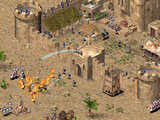 Fans of
the original Stronghold will find Stronghold: Crusader an improvement in
every way—it adds an original and challenging setting, Arab troops and
more combat options, and more and better gameplay modes. But perhaps the
most interesting improvement is that while the original Stronghold
focused perhaps a bit too much on castle- and economy-building over
combat, Stronghold: Crusader does an excellent job of integrating both
its castle-building simulation and real-time strategy aspects. While a
few rough spots remain in the game’s real-time strategy side,
Stronghold: Crusader is still the best combination of these two genres
yet.
Fans of
the original Stronghold will find Stronghold: Crusader an improvement in
every way—it adds an original and challenging setting, Arab troops and
more combat options, and more and better gameplay modes. But perhaps the
most interesting improvement is that while the original Stronghold
focused perhaps a bit too much on castle- and economy-building over
combat, Stronghold: Crusader does an excellent job of integrating both
its castle-building simulation and real-time strategy aspects. While a
few rough spots remain in the game’s real-time strategy side,
Stronghold: Crusader is still the best combination of these two genres
yet.
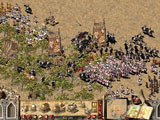 Stronghold:
Crusader puts you in the role of a European Crusader or Arab Sultan
during the period of the early Crusades. While characters such as
Richard I of England (the Lionheart) and Saladin show up, and while some
scenarios bear the names of historical battles, like Antioch, Jersalem,
or Hattin, they serve mostly to add flavor; the game is not a scrupulous
historical simulation.
Stronghold:
Crusader puts you in the role of a European Crusader or Arab Sultan
during the period of the early Crusades. While characters such as
Richard I of England (the Lionheart) and Saladin show up, and while some
scenarios bear the names of historical battles, like Antioch, Jersalem,
or Hattin, they serve mostly to add flavor; the game is not a scrupulous
historical simulation.
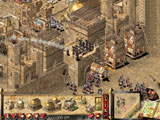 Game
modes abound in Stronghold: Crusader. The game offers a very basic
tutorial, which allows the player to get the feel for the interface, and
a series of four "historical" campaigns: The Call to Arms, Saladin’s
Conquest, The King’s Crusade, and Crusader States. The historical
campaigns actually serve more as advanced (though deep and enjoyable)
tutorials than anything else: The Call to Arms campaign guides you
through the intricacies of combat and establishing an economy; Saladin’s
Conquest allows you to control and become familiar with the new Arab
troops included in the game; and The King’s Crusade gives a firm
grounding in the art of building, defending and assaulting castles.
Finally, the Crusader States campaign is a five-mission skirmish
campaign that prepares you for the real meat of Crusader: Stronghold,
the fifty-mission long Crusader Trail, a skirmish campaign that pits you
against tougher and tougher foes in increasingly difficult
circumstances. Sometimes the Crusader Trail will give you an ally or two
to fight with; more often, you’ll find yourself facing several different
foes. Of course, the game also includes a Custom Scenario mode if you
wish to design your own skirmish games, as well as a sandbox mode, in
which you can happily build castles without any interference from
enemies of any sort.
Game
modes abound in Stronghold: Crusader. The game offers a very basic
tutorial, which allows the player to get the feel for the interface, and
a series of four "historical" campaigns: The Call to Arms, Saladin’s
Conquest, The King’s Crusade, and Crusader States. The historical
campaigns actually serve more as advanced (though deep and enjoyable)
tutorials than anything else: The Call to Arms campaign guides you
through the intricacies of combat and establishing an economy; Saladin’s
Conquest allows you to control and become familiar with the new Arab
troops included in the game; and The King’s Crusade gives a firm
grounding in the art of building, defending and assaulting castles.
Finally, the Crusader States campaign is a five-mission skirmish
campaign that prepares you for the real meat of Crusader: Stronghold,
the fifty-mission long Crusader Trail, a skirmish campaign that pits you
against tougher and tougher foes in increasingly difficult
circumstances. Sometimes the Crusader Trail will give you an ally or two
to fight with; more often, you’ll find yourself facing several different
foes. Of course, the game also includes a Custom Scenario mode if you
wish to design your own skirmish games, as well as a sandbox mode, in
which you can happily build castles without any interference from
enemies of any sort.
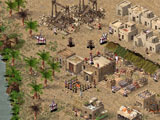 Basic
castle-building gameplay remains much the same in Crusader, though with
enough twists to make things interesting. In most skirmish games, you’ll
begin with a keep, a few peasants, and some raw materials. It’s up to
you to create a thriving economy and imposing army from this rabble.
Generally, this starts by gathering resources on the map--like wood,
stone, iron, and pitch—and getting some farms up and running. After your
minons have delivered some raw resources to your granary and stockpile,
it’s time to start processing them by building workshops—like breweries,
weapons makers, bakeries, and mills. Once you’re producing enough to
keep your people happy, build a castle, and recruit a military force to
make your dreams of conquest a reality, you can even begin to trade
surplus commodities for cold hard cash, which allows you to decrease
taxation rates and recruit mercenaries.
Basic
castle-building gameplay remains much the same in Crusader, though with
enough twists to make things interesting. In most skirmish games, you’ll
begin with a keep, a few peasants, and some raw materials. It’s up to
you to create a thriving economy and imposing army from this rabble.
Generally, this starts by gathering resources on the map--like wood,
stone, iron, and pitch—and getting some farms up and running. After your
minons have delivered some raw resources to your granary and stockpile,
it’s time to start processing them by building workshops—like breweries,
weapons makers, bakeries, and mills. Once you’re producing enough to
keep your people happy, build a castle, and recruit a military force to
make your dreams of conquest a reality, you can even begin to trade
surplus commodities for cold hard cash, which allows you to decrease
taxation rates and recruit mercenaries.
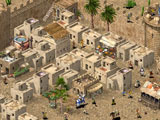 If
this all sounds simple, it usually isn’t. Typically, the problem with
running your economy is that the rampant accrual of resources has to be
balanced with at least some concern for your people, who will leave your
castle in droves if their needs are not met. For example, taxation is
almost always necessary in order to acquire the gold to build certain
structures. But people hate taxes, and raising them will cause your
popularity to nosedive. On the other hand, your peasants love booze,
religion, and nice public spaces, so building a few taverns, churches,
and parks will oftentimes restore you to their good graces. The game’s
economic model is quite deep, and is made even more challenging by
Stronghold: Crusader’s setting. The Holy Land’s deserts don’t offer
nearly enough locations to establish farms or cut trees, and you’ll
almost always find yourself lacking some resource.
If
this all sounds simple, it usually isn’t. Typically, the problem with
running your economy is that the rampant accrual of resources has to be
balanced with at least some concern for your people, who will leave your
castle in droves if their needs are not met. For example, taxation is
almost always necessary in order to acquire the gold to build certain
structures. But people hate taxes, and raising them will cause your
popularity to nosedive. On the other hand, your peasants love booze,
religion, and nice public spaces, so building a few taverns, churches,
and parks will oftentimes restore you to their good graces. The game’s
economic model is quite deep, and is made even more challenging by
Stronghold: Crusader’s setting. The Holy Land’s deserts don’t offer
nearly enough locations to establish farms or cut trees, and you’ll
almost always find yourself lacking some resource.
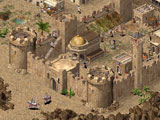 But
while running the economy is both demanding and a hoot, the real fun in
Crusader: Stronghold comes in building a big freakin’ castle. It’s
always rewarding to see your fortress grow from a tiny keep encircled by
a fragile and incomplete wall to a vast complex of towers, moats,
crenellated walls, and deadly war machines. While it isn’t strictly
necessary in most scenarios to build such an imposing edifice (the enemy
AI frankly doesn’t do a very good job of attacking fortifications), hey,
this is a castle-building sim, and the wide variety of nasty
defensive improvements available, from killing pits to war dogs, always
keeps me coming back for more.
But
while running the economy is both demanding and a hoot, the real fun in
Crusader: Stronghold comes in building a big freakin’ castle. It’s
always rewarding to see your fortress grow from a tiny keep encircled by
a fragile and incomplete wall to a vast complex of towers, moats,
crenellated walls, and deadly war machines. While it isn’t strictly
necessary in most scenarios to build such an imposing edifice (the enemy
AI frankly doesn’t do a very good job of attacking fortifications), hey,
this is a castle-building sim, and the wide variety of nasty
defensive improvements available, from killing pits to war dogs, always
keeps me coming back for more.
Of course, if you build a castle, someone’s gonna want to attack it.
That’s just the way it is. Crusader: Stronghold offers a much better
combat system than the original, and again much of this has to do with
the game’s setting and the addition of seven new Arab units. While
generally weaker than their Western counterparts, the Arab units add a
good deal of variety and some interesting tactical options to the game.
While the Arab bow and swordsman units are much like the Crusader units
of the same name, the Slave, Slinger, Horse Archer, Assassin, and Fire
Thrower units are quite different. Slave and Slinger units are cheap and
best used en masse; Slingers can pelt opposing troops with rocks,
and Slaves are fragile and fast torch-carriers. If they can find an
opening in the enemy’s defenses, Slaves can burn down a castle in no
time flat. The Horse Archer unit is very impressive, and their
combination of fast move and effective attack makes them great raiders.
Assassins, on the other hand, are just about as effective as Swordsmen,
but also have the ability to climb castle walls. I gotta admit, I love
these guys and probably overuse them, but they’re terrific at capturing
towers, especially those guarded by hand-to-hand wussies like archers.
Fire Throwers are just that—troops that huck firebombs. When defending
from castle walls they’re amazingly effective against even the toughest
enemy troops.
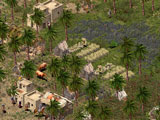 The
new Arab troops make an enormous difference in Stronghold: Crusader not
only because they add variety, but also because you can purchase them
almost immediately in most skirmish games. This means that you (and your
enemies) will usually field significant military forces before
significant defenses have been built. No more waiting, as in Stronghold,
for your economy to grow before assembling an army--in Crusader you can
build a mercenary tent, buy up a bunch of slaves, and send them off to
burn an enemy to the ground right away. While this does make most games
much more action-packed—you have to be ready for enemy attacks from the
get-go—it also allows the player to engage (perhaps too much) in
early-game "rush" tactics. I’ve won several games on the Crusader Trail
by selling off everything at the beginning of the game, hiring a mess of
swordsmen, and systematically storming my opponent’s half-constructed
castles. Great if you’re the Zerg; less good if you’re into a deliberate
castle-building game.
The
new Arab troops make an enormous difference in Stronghold: Crusader not
only because they add variety, but also because you can purchase them
almost immediately in most skirmish games. This means that you (and your
enemies) will usually field significant military forces before
significant defenses have been built. No more waiting, as in Stronghold,
for your economy to grow before assembling an army--in Crusader you can
build a mercenary tent, buy up a bunch of slaves, and send them off to
burn an enemy to the ground right away. While this does make most games
much more action-packed—you have to be ready for enemy attacks from the
get-go—it also allows the player to engage (perhaps too much) in
early-game "rush" tactics. I’ve won several games on the Crusader Trail
by selling off everything at the beginning of the game, hiring a mess of
swordsmen, and systematically storming my opponent’s half-constructed
castles. Great if you’re the Zerg; less good if you’re into a deliberate
castle-building game.
Crusader’s 2-D graphics are not eye-popping, but they are quite good.
I’m especially impressed by how well the game’s different views and
interface allow the player to track the game’s complicated actions and
events. Sound is very nice as well, and I’m much taken with the rants
your foes will launch into any time you do them harm.
Just in case you manage to play through all the campaigns and the
Crusader Trail, the game also includes a very nice map and scenario
editor. I gotta say, there’s a lot of gameplay here. If you wish to play
a multiplayer game, you can go with either LAN or TCP/IP, and
Stronghold: Crusader is also supported by Gamespy Arcade.
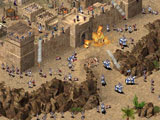 For all
the good things about Stronghold: Crusader, there do remain a few flaws,
and most of them still have to do with the combat system. While the game
is superb as a castle-builder and economic sim, the real-time combat
system is underdeveloped. For example, you cannot lay waypoints or rally
points for units, combat stances are very limited, and troop AI, while
not dumb, is very—passive. To get your units to do things—in fact,
almost anything--you usually have to issue them commands, and this type
of niggling can become very tiresome, especially when trying to
co-ordinate archers, swordsmen, war machines, and ladder carriers during
a siege on an enemy castle. Again, combat is much better than in
Stronghold, and even much better than in any building sim I can think
of, but it still lags well behind current RTS benchmarks.
For all
the good things about Stronghold: Crusader, there do remain a few flaws,
and most of them still have to do with the combat system. While the game
is superb as a castle-builder and economic sim, the real-time combat
system is underdeveloped. For example, you cannot lay waypoints or rally
points for units, combat stances are very limited, and troop AI, while
not dumb, is very—passive. To get your units to do things—in fact,
almost anything--you usually have to issue them commands, and this type
of niggling can become very tiresome, especially when trying to
co-ordinate archers, swordsmen, war machines, and ladder carriers during
a siege on an enemy castle. Again, combat is much better than in
Stronghold, and even much better than in any building sim I can think
of, but it still lags well behind current RTS benchmarks.
I’d heartily recommend Stronghold: Crusader to almost anyone,
especially strategy gamers, those who liked the original or enjoy
building sims, and anyone who’s willing to give a smart, complex, and
fun game a shot. On the other hand, hardcore RTSer’s might be somewhat
dismayed by the game’s less than state-of-the-art combat. Here’s hoping
that there’s yet another installment of this excellent series in the
offing, and that it corrects that fault.
